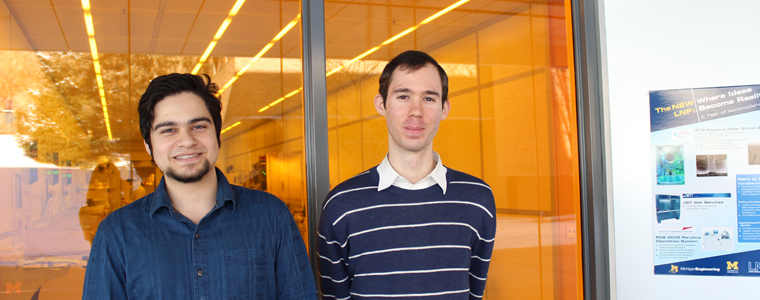Student team reaches Qualcomm finals with their proposal for a wearable haptic device
The goal of the project is to augment the transmission of audio and video with the sense of touch.

 Enlarge
Enlarge
Paul Myers, EE Senior, and Amin Sandoughsaz, EE PhD student, were selected as finalists for the 2015 Qualcomm Innovation Fellowship (QInF). They will present their project, A Wearable Haptic Device with Integrated Sensing and Actuation for Next Generation Communication Systems, at the QInF Finals on March 23, 2015 in San Diego, where at least 8 teams with the most innovative proposals will win. Paul and Amin are one of 146 teams that applied for the $100,000 fellowship, and one of only 35 selected as finalists. They are being advised by Prof. Khalil Najafi and Prof. David Blaauw.
The goal of the project is to augment the transmission of audio and video with the sense of touch. They envision a device that will be able to transmit touch with far greater sensitivity than is currently available with today’s virtual reality games or similar systems.
Imagine, say Amin and Paul, a new father who has been sent overseas to serve in the armed forces. While he could be satisfied with an image or possibly a recording of the voice of his newborn child, imagine if he could reach out and touch the baby while thousands of miles from home. This could be in the future with their proposed haptic (ie, touch) device. The team wants to create a method of storing physical sensations which could then be transmitted along with the image and sound data.
Applications for such a device range from the personal, as already described, to the commercial, such as getting a better feel for new products before purchasing them online. In addition, Sandoughsaz and Meyers believe that a device that is capable of accurately modeling the human haptic response would greatly aid in the understanding of the nervous system and could enable the development of assistive technologies capable of restoring sensory function to patients suffering from dissociated sensory loss.
To add the sense of high-quality touch to general wireless transmissions, the team conceived of a high-resolution, flexible haptic system. This system consists of an array of miniature tactile sensors and actuators, each of which is controlled independently to accurately recreate the sense of touch. The haptic sensing and feedback hardware interface exploits Micro-Electro-Mechanical Systems (MEMS) technology, and can be produced in a cost-effective manner.
Amin and Paul say they have much to do before the finals in March, but they are excited to be working on the project and representing Michigan.
About the team members
Amin Sandoughsaz came to Michigan as a PhD student in 2013, and is a member of Prof. Khalil Najafi’s research group. He has extensive experience in a variety of fabrication processes, having begun his cleanroom experience in 2010 and continuing in the Lurie Nanofabrication Facility (LNF). He has fabricated a number of MEMS devices, including a micro machined, integrated, high-flow, high-pressure gas micropump. Amin has published four papers in top MEMS journals, including Journal of Microelectromechanical Systems and Journal of Micromechanics and Microengineering.
Paul Myers has delved into many fields in his time as an undergraduate student at Michigan, including ultra-low power circuit design, solid-state electronics, photonics, and high-energy physics. He has fabricated devices in the Lurie Nanofabrication facility and has experience in PZT-based systems. He currently works in the Michigan Integrated Circuits Lab (MICL) under the supervision of Prof. David Blaauw. Paul has co-authored two papers, one of which was published as part of the IEEE Sensors 2014 Conference; the other is currently under review by a professional journal.
 MENU
MENU